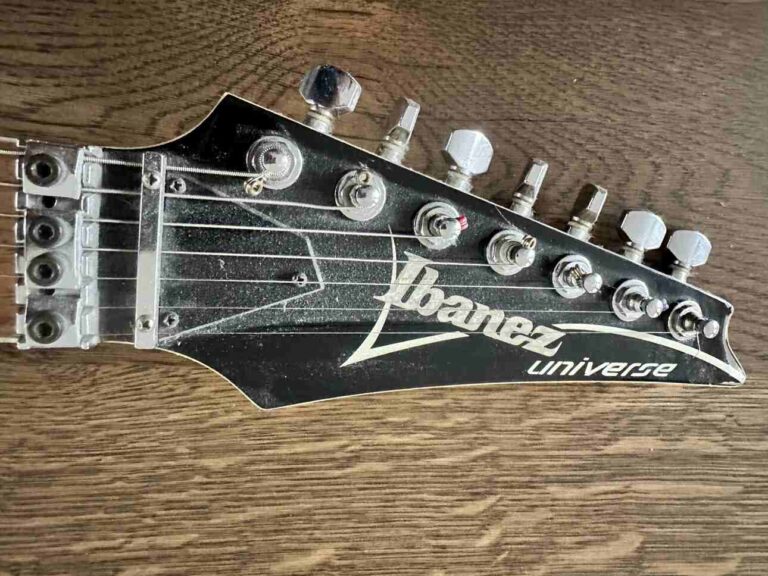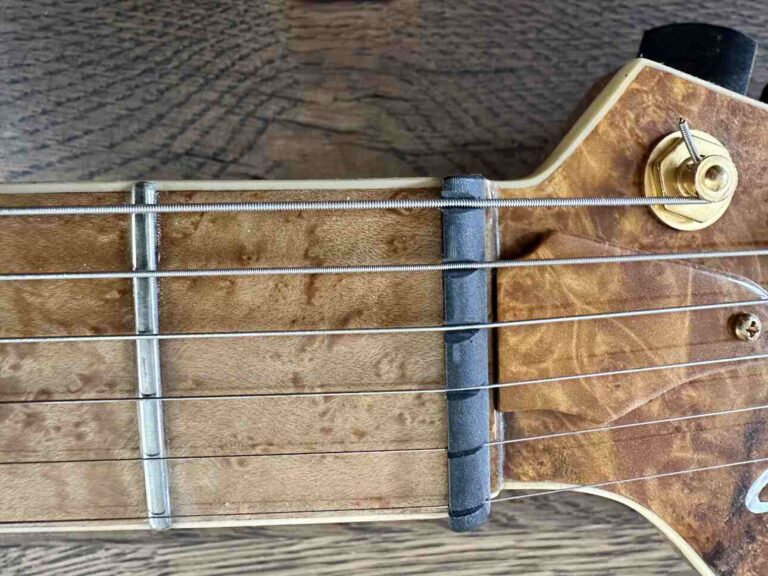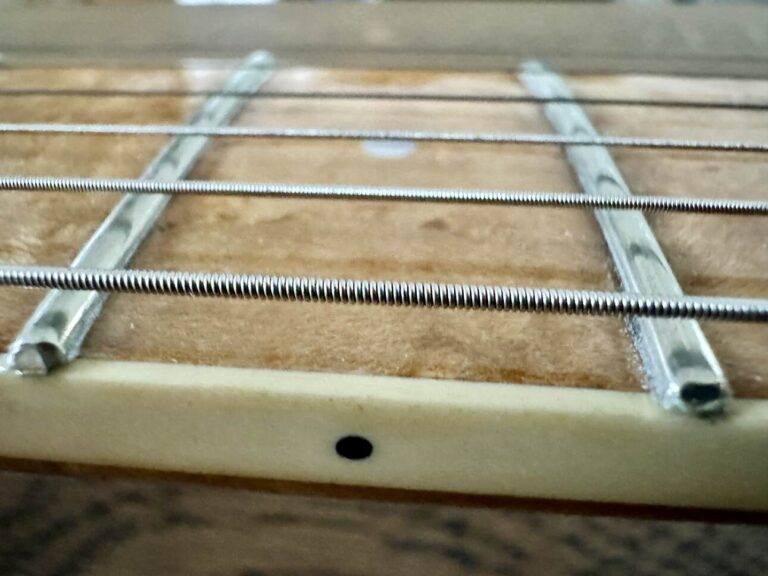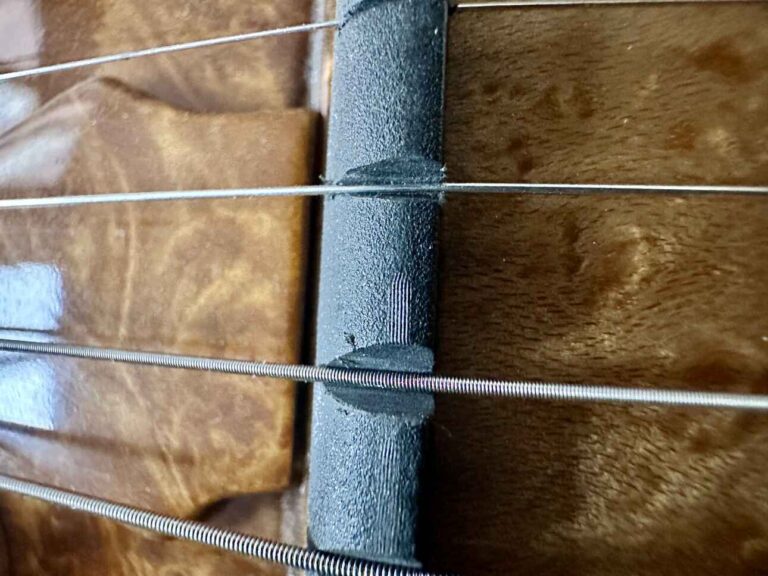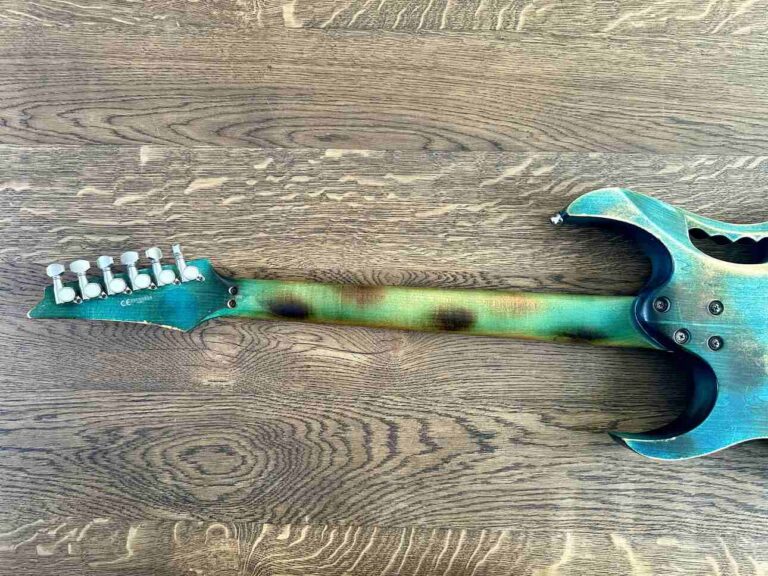What to do if guitar pickups are too hot? Quick Fixes Explained
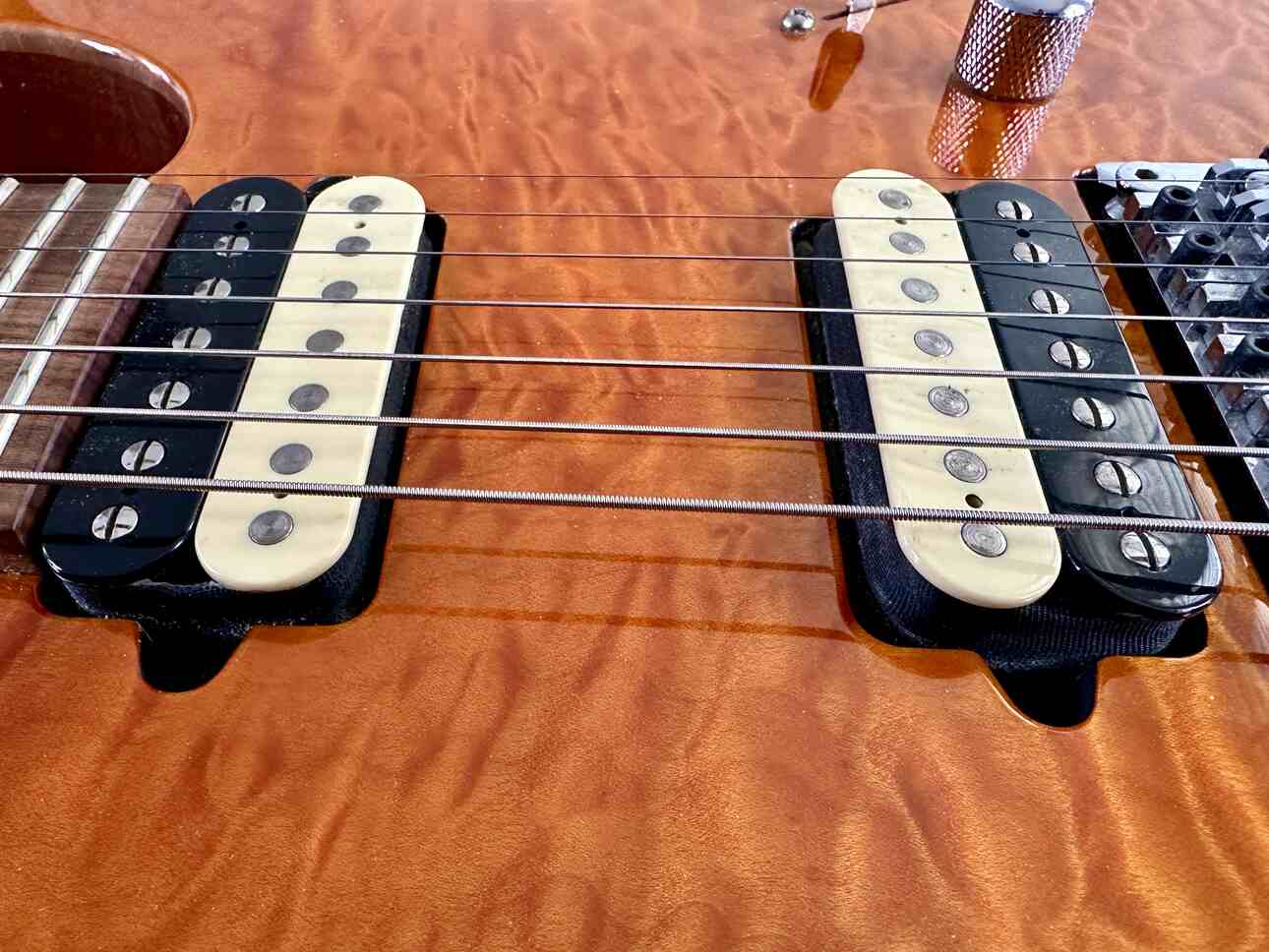
Sometimes, guitar pickups can be a bit too powerful, leading to a sound that’s not quite right. If you encounter this snag, don’t sweat it. There are actions you can take to dial things back and hit the sweet spot for your guitar’s sound.
To kick things off, it’s key to spot the tell-tale signs of pickups that are cranked up too high. Look out for a tone drowning in distortion, a tone that sounds murky, or when the notes you strum don’t come through clean.
It’s essential to figure out if your guitar’s pickups are the culprits behind these sound issues. If they’re to blame, tweaking the height of the pickups could be the fix you need.
Nailing the ideal pickup height can bring out the best in your guitar’s tone and your playing style. This tweak is all about the space between the pickups and the strings.
Get it right, and you’ll enjoy an evenly distributed sound with just the right amount of edge and no unwanted noise.
Wanna know more? Keep reading!
Key Takeaways
- Noticing ‘hot’ pickups means spotting troubles such as too much distortion and a muddy sound;
- Fine-tuning the height of your pickups can help solve problems with their high output;
- Getting the pickup height just right improves the warmth, clarity, and sustain of your guitar’s sound.
What to Adjust if Your Pickups Have Too Much Output?
You might hear unwanted buzz or overly distorted tones when your guitar’s pickups are cranked up too much. No stress, though – there are a bunch of ways you can get that under control. Let’s explore some tweaks that can chill out your pickups’ output.
Start by tweaking the height of your guitar’s pickups. This move can seriously dial down the output.
You’ll want to back the pickups off from the strings by turning the screws on the sides a bit looser. This gap between the pickup and the strings can tone down that intense output.
Take it slow, though. Each type of pickup might need its own tweak. Listen to what the folks who made your pickups suggest.
You could also take a look at the knobs on your guitar that control tone and volume. Messing with these can make a big difference in how your guitar sounds.
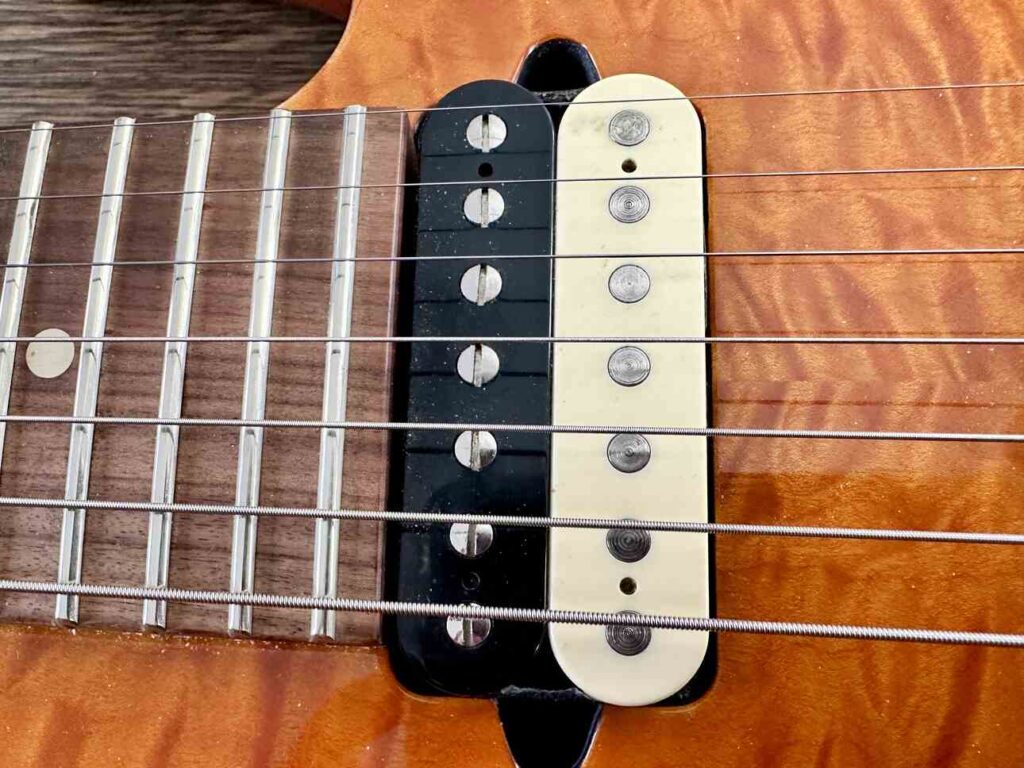
For example, drop the volume a touch or mess with the tone knob until you get a mellower vibe. This can cool off pickups that are coming in too hot and heavy.
If those quick fixes don’t work, consider a deeper dive into your guitar’s guts. Swapping out the potentiometers (those are the pots) for ones with a higher resistance might give you a less intense response. It brings down that sizzling output.
Or swap out the capacitors for ones with different values to tweak the tone and impact the pickup’s output.
If everything fails, you might have to say goodbye to your current pickups and grab some with less oomph. It’s tough to let go, but it’s worth considering if you need a big switch-up.
Scout out different pickups and pick one that complements your playing style and the sound you’re after.
Understanding Guitar Pickups
Magnetic Field and Coil
Understanding guitar pickups is key to getting the sound you want from your electric guitar. At a pickup’s core is the combination of a magnet and a coil. They establish the magnetic field.
This magnetic field comes from the magnet, with the coil consisting of wire wound around it.
Strumming a string on your electric guitar shakes up this magnetic field. It creates a voltage in the coil. This electrical signal travels to your amp, transforming into the sound you hear.
Single Coil vs Humbucker
Electric guitars use one of two primary pickup types: single coil or humbucker.
Single-coil pickups have a single magnet and coil setup. They deliver a crisp and articulate sound. Yet, they’re known to pick up some hum and noise along the way, which isn’t always ideal.
Humbuckers are designed with two coils connected out of phase. This clever configuration neutralizes the hum and noise single coils can pick up. Humbuckers also offer a more potent output and yield a richer, more robust sound.
Active vs Passive Pickups
Electric guitar pickups are generally divided into two categories: active and passive.
Passive pickups, the more traditional type, operate without an external power source. They’re known for their straightforward design and the ability to create a warm, classic sound. Despite this, they may have a lower output and sometimes produce too warm or muddy tones.
Active pickups, in contrast, need a battery-powered preamp. This setup boosts the signal, leading to greater clarity in the output. They give lots of sound possibilities.
It makes them a solid choice for experimenting with styles and genres. But know that active pickups might sacrifice some of the warmth in passive models to achieve that crisp, clear output.
Humbuckers offer a more potent output
and yield a richer, more robust sound
Signs of Excessively High Guitar Pickups
Loss of Sustain
If pickups are too close to the strings, they can hamper their natural vibration. This, in turn, reduces sustain. Sustain is essential for maintaining a smooth, uninterrupted sound. Any decrease can impact the quality of your playing.
Awareness of this problem allows you to change your pickups’ height to achieve the best spacing from the strings. This can significantly enhance your guitar’s sound. Adjusting pickup height is a delicate process.
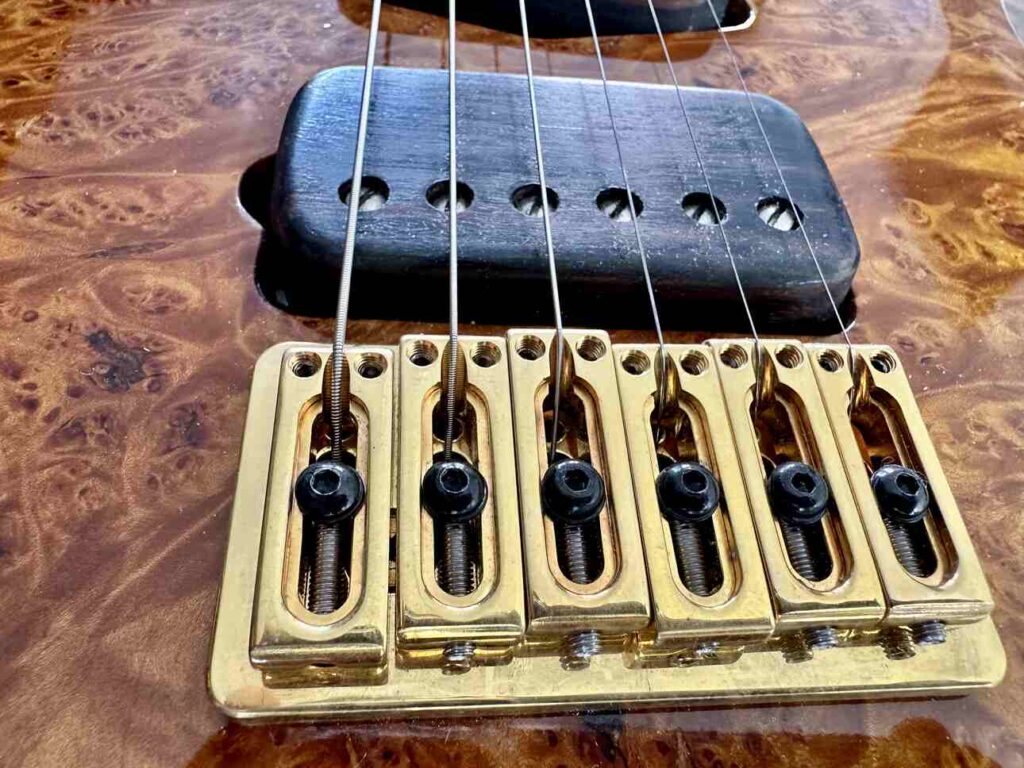
Undesired Feedback
Excessively high guitar pickups can also cause unwanted feedback. When high-output pickups are set too close to the strings, they might make your guitar prone to intrusive noise. This can muddy your tone’s clarity.
To avoid this problem, examine your pickups’ height closely. Lowering them can help cut feedback and clean up your sound if they’re too high.
Intonation Problems
Pickups that are adjusted too high might lead to intonation troubles. The magnetic field can tug on the strings and mess with their vibration, throwing off the pitch.
If your guitar drifts out of tune or hits the wrong notes, it could be a sign that your pickups are too snug against the strings. Alter the height to tackle these intonation problems.
String Pull
If your guitar pickups are set too high, they might tug on your strings more than they should. That tug messes with the strings’ ability to wiggle around properly, making your guitar go out of tune or just not sound right.
The first step is to spot the problem with string pull. Once you understand what’s going on, you can fix it by tweaking how high or low your pickups sit.
Setting the Correct Pickup Height
Measuring Pickup Height
To measure the pickup height, push down on the strings at the furthest fret from you. Then, check the gap between the strings’ underside and the tip-top of the pickup poles. You want them super close but not bumping into the strings.
Adjusting Single Coils and Humbuckers
You can tweak single coil pickups (like the ones in Stratocasters) by twisting the screws on the pickup’s sides to change how high or low it sits.
Lifting the pickup makes it louder, and dropping it down makes it quieter. Tread carefully with these changes; they make a big difference in your tone.
The same goes for humbucker pickups (like the ones in Les Pauls), also offer this possibility.
These tweaks can significantly shape your guitar’s sound character.
Finding the Sweet Spot
Listen to your guitar as you dial in the settings. Adjust the pickup height bit by bit. Trust your ears to guide you.
Your axe’s voice changes with the pickup’s altitude, and there’s no one-size-fits-all spot. Each player’s ideal zone will vary. But with some attention and tweaks, you’ll find that perfect mix of loudness and sound quality.
Make those tweaks gently and gradually. Then, listen to how your sound shifts to nail the sound you’re after.
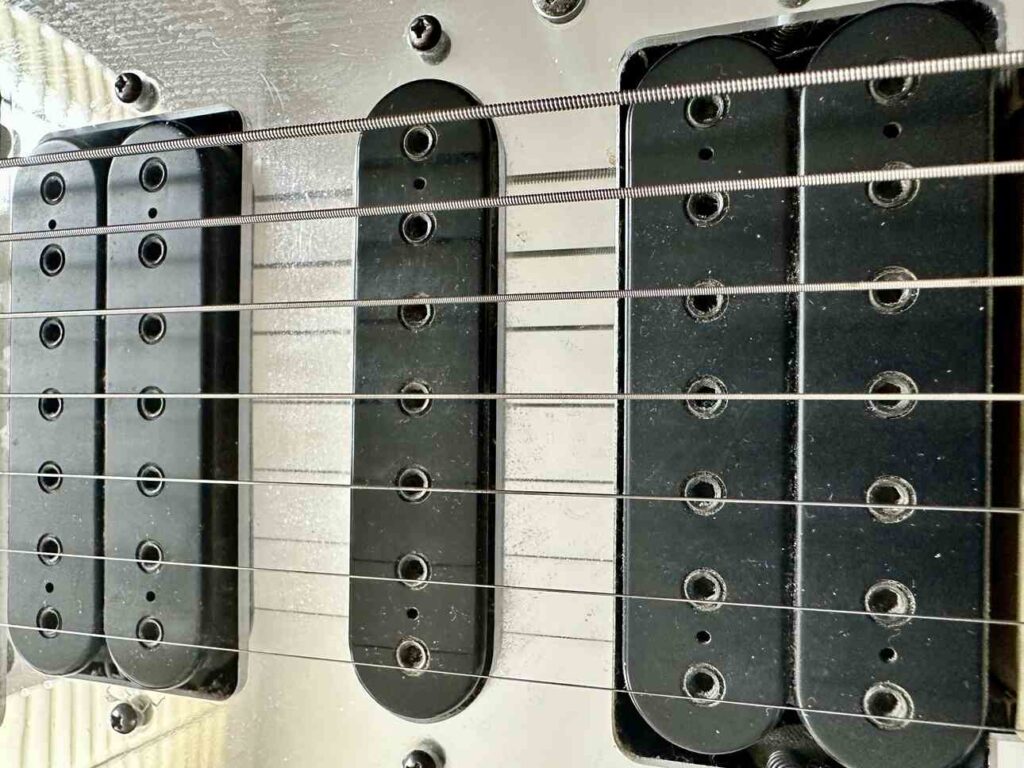
Optimizing Pickup Height For Your Playing Style
Considerations for Different Genres
Every style of music has its own vibe and what guitar players need from their gear.
To get your guitar’s pickups just right for your favorite kind of tunes, think about these tweaks:
- For the rock and metal crowd cranking up the gain, dialing down your pickup height might take the edge off and balance out your sound;
- Jazz cats looking for that smooth, deep tone might want to drop their pickups a bit further from the strings for that chill vibe;
- Blues and country players who are juggling clean and gritty sounds could choose a middle-of-the-road pickup height. It helps them churn out clear notes that can growl when you push ’em.
Adjustments for Playing Dynamics
If you mix up fingerstyle and play with a pick, setting up your pickup height right can give you more ways to express yourself.
Here’s how you can adjust the pickup height to suit your dynamic playing:
- Fingerpickers might like the treble side of the pickup a little higher than the bass side. It’ll make the high strings stand out with a bit of sparkle, balancing nicely with the naturally deeper tones of the low strings;
- For those who play with a pick, bringing the pickups down can keep the strings from getting too wild and noisy when digging in.
Troubleshooting Common Issues
Balancing Volume Across Pickups
When hot pickups have an imbalance in volume, check out their height and tweak as needed.
Bringing the pickup down closer to the pickguard might even things out. Just watch out not to go too far and mess with your string action.
Play around with different heights to hit the sweet spot for how you play.
Also, think about the kind of guitar pickups since some are naturally more intense.
For example, high-output humbuckers usually pack a stronger punch than single coils. If you’re struggling with a certain type, it might be smart to chat with a guitar tech to figure out the best pickups for your guitar and your playing style.
Dealing with Microphonic Feedback
Microphonic feedback is that annoying loop when your amp’s sound gets sucked up by your pickups and blasted out again.
To stop this, make sure your guitar has good shielding. Double-check that the pickguard’s shielding is on point and that the guitar’s cavity is shielded correctly.
After that, take a look at your strings.
They shouldn’t be touching the pickups, or they’ll start howling with feedback.
If your strings are hugging the pickups too tight, tweak the bridge height or saddles to give them some breathing room.
Pickup Height Adjustment Tools and Techniques
Essential Tools
Before diving in, round up the tools you’ll need to tweak your pickups.
Here’s what to grab:
- A screwdriver (Phillips or flathead usually does the trick) for turning those pickup screws;
- A ruler or string action gauge that shows 64ths of an inch or millimeters for precise pickup height setting;
- A capo or string retainer to keep those strings in place and stop them from wiggling around while you work;
- Painter’s tape or masking tape to keep your guitar’s finish safe and scratch-free.
Precision Adjustment Methods
Take it slow and steady when you’re ready to adjust those pickups. Here’s a step-by-step guide:
- Get your guitar in tune because the tension on the strings can change things up;
- Slap a capo on the first fret to keep your strings steady and out of the way;
- Whip out your ruler or string action gauge and measure the space between the strings and the pickup poles. Write those numbers down to keep track of your adjustments;
- Now, twist the screws on the pickups to change their height;
- If your pickups are blasting too loud, lower them away from the strings to chill them out a bit;
- A good starting point is to set the bass side a bit lower than the treble side so it sort of matches the curve of your fretboard;
- Take off the capo and give your guitar a strum to feel the new vibes in output and tone;
- Keep tweaking those heights bit by bit until you’ve dialed in the sound you’re looking for.
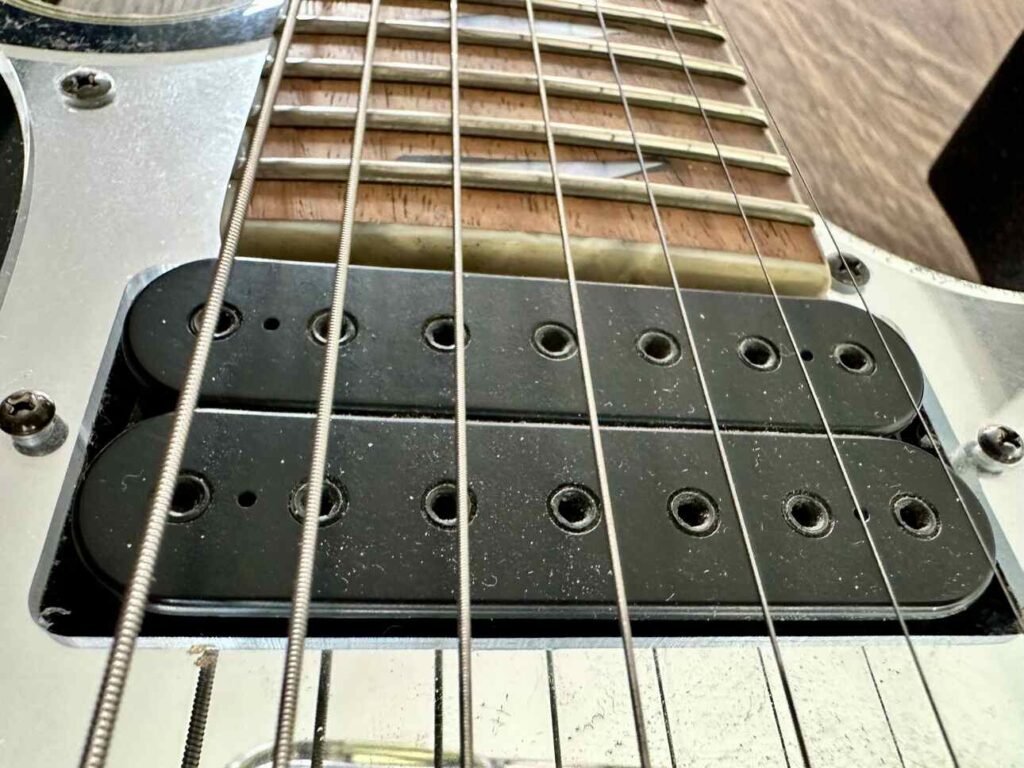
When to Consult a Professional
Challenging Pickup Designs
Dealing with intricate guitar pickup designs from brands like Fender or Seymour Duncan can be tricky.
For these more involved setups, it’s a smart move to hire a pro who knows how to handle that particular type of pickup.
A technician can handle the detailed work these pickups need.
Here’s a list of some complex pickup types where a tech’s help could be invaluable:
- Active pickups that come with their own preamps;
- Pickups that have various coils or offer different sound options;
- Pickups that are part of the pickguard setup.
Major Modifications
At times, guitar players need to make big changes to their axes.
Serious mods can involve changing the pickup layout for instance. But also carving out new cavities, reshaping the pickguard, or making other big tweaks to fit new pickups.
Calling in a pro for this kind of heavy-duty work is probably a good idea.
Getting a professional’s help makes sure your guitar stays easy to play and doesn’t lose its solid build.
Maintaining Optimal Pickup Height Over Time
Regular Check-Ups
Keeping an eye on your guitar’s pickup height is key for any player. Regular checks keep them at the perfect height for that sound you love.
Give your pickup settings a look every couple of months.
Kick things off by measuring the pickup height with a ruler or tape next to each pickup. Press the string down as you do.
For single coils, aim for between 2.4mm and 4mm. For humbuckers, aim for about 3.2mm to 4.8mm. The Guitarist’s Guide to Setup & Maintenance shows that tweaking your pickup height can improve your sound.
Effects of Environmental Changes
Your guitar’s sound and the setup of its pickups can get thrown off by changes in your environment.
If your guitar faces wild temperature swings or too much dampness, your pickups might not work as well.
As Guitar Setup, Maintenance & Repair states, keeping your guitar steady is key to avoid fiddling with it too much.
Make sure to store your guitar out of the sun, away from heaters, and out of the cold. A space where the temperature and moisture in the air stay pretty much the same will help it play its best.
Frequently Asked Questions
How can I tell if my guitar pickups are set too high?
If your guitar pickups are too high, you might notice the guitar doesn’t hold a note for long. And the strings could even bump into the pickups when you’re playing hard.
To check, hold down the strings at the last fret and measure the gap to the pickups. You might want to lower your pickups a bit if it’s pretty snug.
What are the symptoms of overheated guitar pickups?
Pickups that get too hot can mess with your sound. They can give you a nasty distortion, squash your dynamics, and make your guitar less responsive. Overheating can wreck your pickups, so it’s best to sort it out quickly.
Is it possible for guitar pickups to become damaged from excessive heat?
Yep, too much heat can fry your guitar pickups. Some types can take the heat better than others, but if they get too hot for too long, they can damage the magnets and coils inside them.
If they get cooked, they might not work right anymore, and that’ll mess up how your guitar sounds.
How does pickup height affect my guitar’s tone?
The spot where your pickups sit can affect your guitar’s sound and loudness. Moving them closer to the strings will give you a louder, sharper sound.
But they can get in the way and make things sound bad if they’re too close. Moving them down gives you a quieter, softer sound.
What should I do if my guitar’s sound is too harsh or muddy?
If your guitar sounds rough or too thick, it might be time to fiddle with your pickups. Or get some new ones. Or even have them rewound.
Start by playing with the pickup height; it can make a huge difference in how your guitar sounds.
If that doesn’t clear it up, a guitar tech can examine it and determine what to do next.

